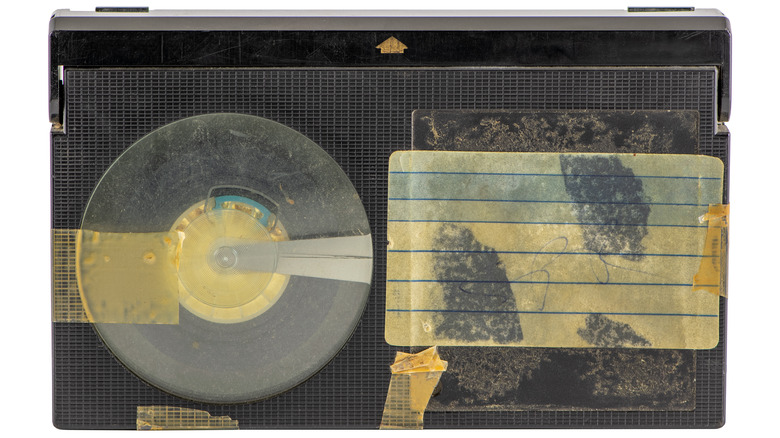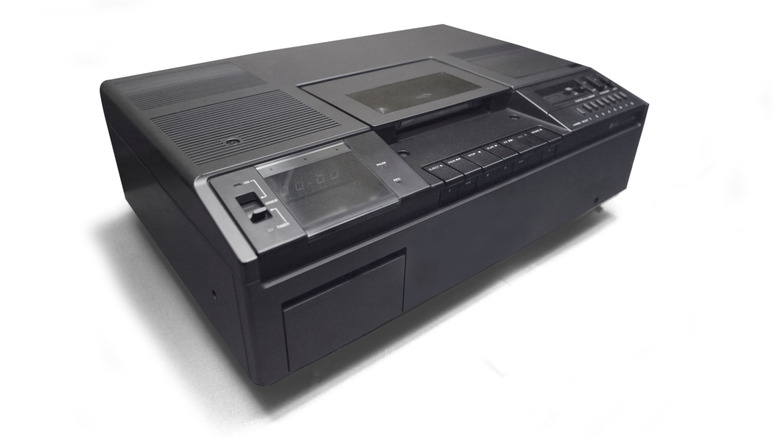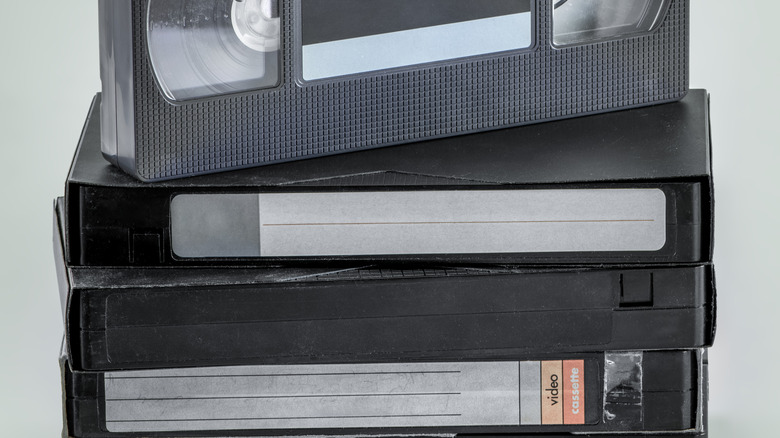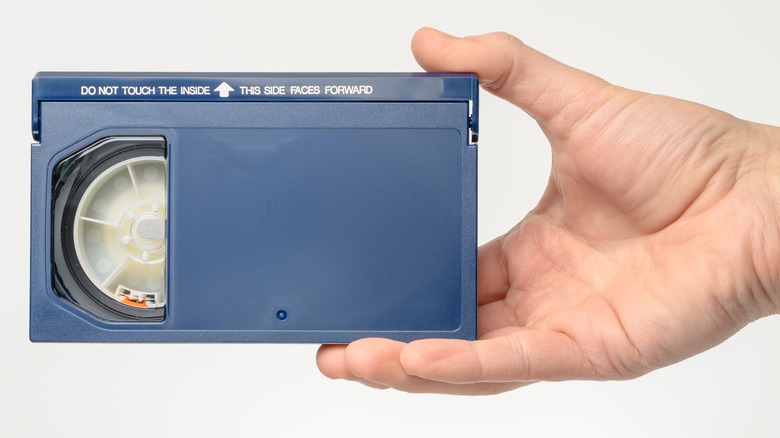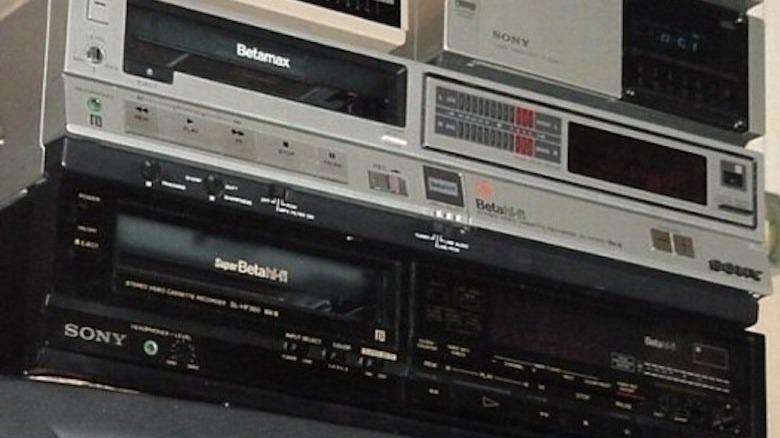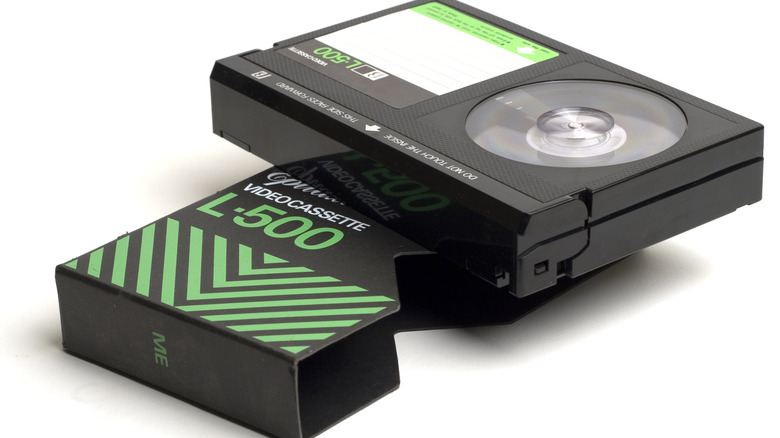What Happened To Betamax Tapes?
Does anybody still remember Betamax tapes? For readers of a certain age, these definitely need little introduction. But back when Sony's Betamax format debuted close to 50 years ago, it was, at least for those who could afford one of the bulky, clunky, and pricey home-use videocassette recorders of the era, it was the greatest thing since sliced bread. Granted, Sony wasn't the first company to release a VCR, but its Betamax recorders and videotapes were the first to become household names for consumers. And with VHS entering the conversation soon after, both formats competed with each other from the late '70s to the late '80s, at which point there was one format that unquestionably ruled over the other — and that format's name was not Betamax.
Nowadays, both Beta and VHS are seen as relics of a bygone era, two forms of technology that are completely irrelevant in this era of Netflix, YouTube, and various other platforms that confuse the world's population of old men (and women) yelling at cloud. That is why we're going to be looking at the first of these two formats and taking a look at what happened to Betamax tapes, as well as the VCRs that supported them.
Beta means better (among other things), and Max means maximum
When Sony first came up with the idea for Betamax in 1973, the VCR was seen as the next big tech advancement — what if consumers could record an hour's worth of video and audio on a device connected to a TV, then rewatch the recorded programs at their own convenience? It was a revolutionary idea for the time, but at first, the technology had a rather unwieldy name — "Azimuth Recording." Not really the easiest thing to remember, but the internal codename, "Beta Recording," was halfway there.
According to Sony's website, "beta" had several meanings. First, that was a Japanese word for the manner in which signals were recorded onto the cassette tapes to be used in the still-in-development recorders. Secondly, the tape path in the recorders' loading systems resembled the shape of the Greek letter beta. And lastly, "beta" sounded like a phonetic variant of the word "better." The "max" at the end? Why, that was simply short for "maximum." So with that combination of words, Sony had a short, punchy new brand name, and on April 16, 1975, the first Betamax products were announced — the SL-6300 VCR deck, which was similarly priced to a large color TV, and the LV-1801, which was an 18-inch color television set with the SL-6300 included. As you could probably guess, the latter item cost almost twice as much as the former.
The videotape format war is on: Here comes a new challenger!
Per Sony, the home-use VCR had "created the greatest expectations" for the company since its Trinitron television sets debuted, but demand for such products was still relatively low. Still, Sony executives remained optimistic, and more and more Betamax machines were being produced in the months after their launch. But rival tech giant JVC had a trick up its sleeve, and in September 1976, it released its own VCR series with a totally different format to compete against Sony and Betamax. That format, of course, was VHS, and it had one key advantage over Betamax — VHS cassettes could store up to two hours of recorded video and audio, or twice as much as Beta's limit. With that, the VCR (or videotape format) war was on, and home-use recorders exploded in popularity as both Sony and JVC courted their respective share of companies to manufacture and sell Beta or VHS products.
Although it was great that VHS allowed people to record much more content, Beta boosters have always maintained that the technology has some clear advantages over its rival. Without going into all the video tech gobbledygook, Betamax machines had a larger head drum, allowing for better recording quality. There was also the introduction of Beta Hi-Fi in 1983, which greatly improved audio quality, as well as the reduced wear and tear on Beta cassettes due to the fact that Beta VCRs used fewer video heads than their VHS counterparts.
The real reasons why Beta was trounced by VHS
Yes, we understand that VHS, too, is a dated form of technology, but more than a decade after it debuted on the heels of Betamax's arrival, it was the overwhelming choice for consumers. As pointed out by Legacy Box, early Beta machines were also heavier than their VHS equivalents, and their parts were also pricier. But even with the tapes and machines shrinking in size and recording quality improving drastically, buyers were still likelier to gravitate toward VHS. That was because longer recording time was the feature that appealed the most to consumers, and with good reason — people simply want to get more bang for their buck, especially as VHS tapes eventually allowed users to record well over the original two-hour limit.
Seeing that consumers were opting for VHS so that they could record full films on one tape, and that they could potentially rent or buy movies from video stores, JVC started partnering with film distribution and production companies — a seeming death blow to Betamax's relevance in the market. Sony did extend the recording time of Betamax cassettes in hopes of keeping up with the Joneses, but as of 1987, VHS was the undisputed industry leader and would remain on top until DVD technology emerged in the late '90s.
In addition, there are a few other reasons why Beta lost the battle of the VCR/videotape formats. Experts who spoke to MacWorld in 2006 mentioned factors such as JVC's decision to make VHS licensing more open (as opposed to Betamax, which was Sony's proprietary format), as well as the lucrative adult film industry's preference for VHS.
Sony stopped making Betamax VCRs in the early 2000s
The year is 2002. Eminem is still far more Slim Shady than Rap God. "Jackass" has just wrapped up its run on MTV (which, at this point, was still mostly about the music), but Johnny Knoxville and company still have a lot of spinoffs, movies, and crazy stunts left in the tank. "Spider-Man" becomes a box office smash, but the Marvel Cinematic Universe is far from being a thing. Betamax does not have a place at all in this zeitgeist, but somehow, Sony is still manufacturing two Betamax VCR models. That is, until the company announces in August that it will discontinue production on both models by the end of the year.
As noted by the Los Angeles Times, Sony's announcement was a "formality" for U.S. consumers, as it had been at least a decade since electronics stores had stopped selling Betamax VCRs and cassettes. But the move came at a time when there was still a community of "Betaphiles" who tried to keep the format alive by purchasing used VCRs and refurbishing them, then ordering old tapes to watch on those machines. Many of these Betaphiles remained loyal to the now-anachronistic technology, swearing by the superior picture and sound quality in comparison to VHS.
All in all, it was estimated that there were about 100,000 people in the U.S. who still used Betamax VCRs in 2002, and those that wanted a new machine had to pay a premium price — the last two remaining models sold in Japan for the equivalent of $750 and $2,050 in U.S. currency.
The end of an era
Given the technological advances that have made it so easy to record high-quality videos with one's mobile phone, it may surprise some of you to know that Betamax video cassettes were still being sold well into the 21st century. To be specific, they were sold for more than 13 years after Sony announced that it would no longer be manufacturing Betamax VCRs.
The official end of the Beta era was heralded by Sony's announcement in November 2015 that it will no longer be selling Betamax cassettes effective March 2016 (via BBC). Along with this move, the company announced that it would be discontinuing a separate product — the Micro MV cassette — for compatible video cameras some 10 years after it manufactured the last camera that supports the item.
In the above report, BBC quoted a number of people who rued the imminent discontinuation of the format's cassettes. BBC video editor Pete Doherty fondly looked back on watching Michael Jackson's iconic "Thriller" video for the first time on Betamax, adding that this was the time when people were "just beginning to watch things on demand." He did, however, admit that he doubted that many people would miss Betamax once Sony stopped producing compatible cassettes, as he "can't imagine there are many machines left to play them on."
Yes, it may have been a dark day for many people who grew up in the '70s and '80s, but let's face it — if you're looking for quality video recording in the 21st century, it just wouldn't make sense to use technology that's been obsolete for decades.
